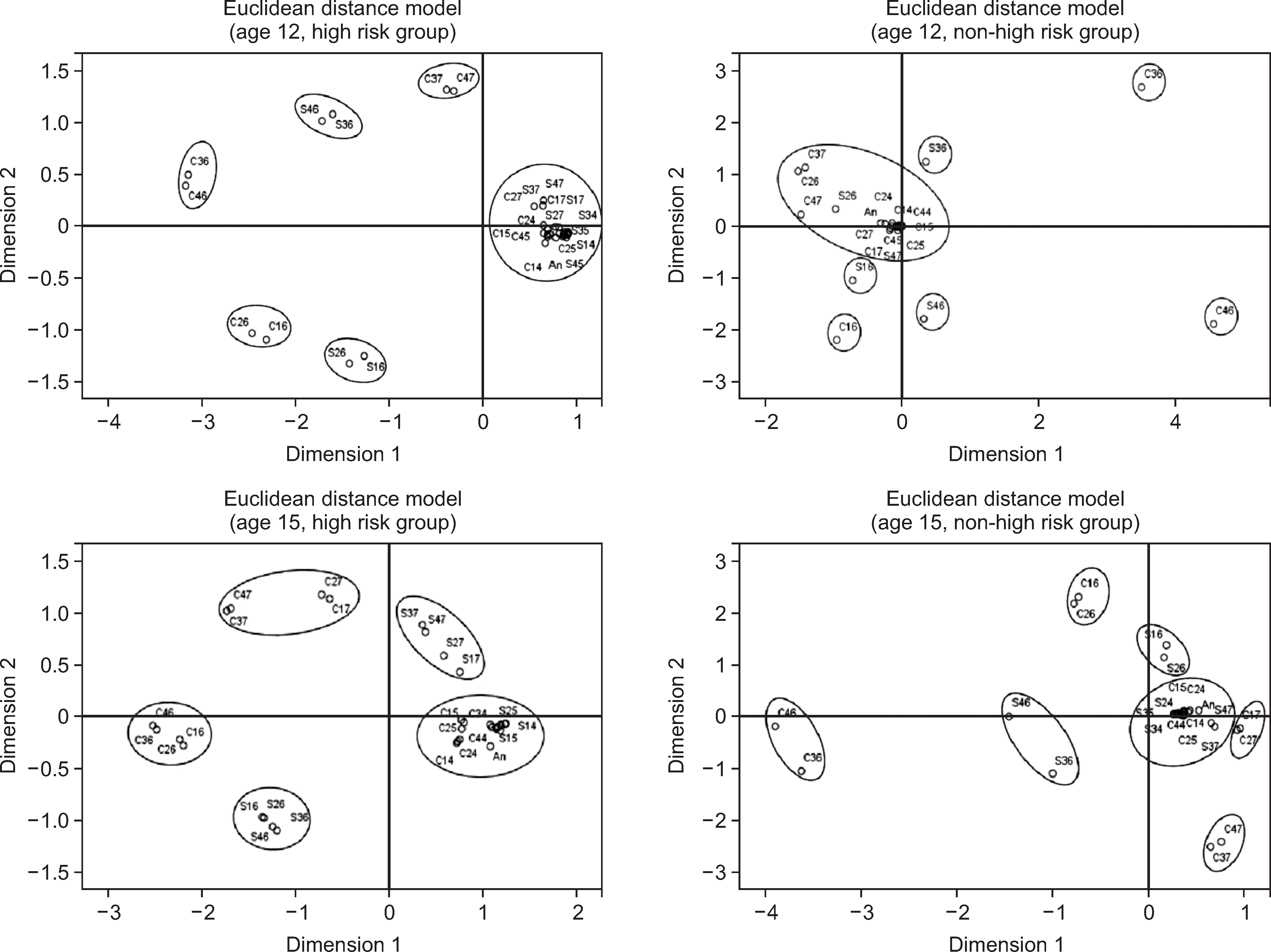Abstract
Objectives
The purpose of this study was to analyze the pattern of dental caries in a high-risk group of Korean adolescents.
Methods
Raw data on 10,542 adolescents between the ages of 12 and 15 years from the 2012 Korean National Oral Health Survey was used. The subjects were divided into a high caries risk group and non-high caries risk group for analysis. For the statistical analyses, we utilized a frequency analysis, descriptive statistics, and a multidimensional scaling analysis.
Results
The pattern of dental caries in the high caries risk group were divided into six classifications for 12-year-olds and five for 15-year-olds, including the mandibular first molar occlusal surface (Cluster 1). In the high caries risk group, the frequency of Cluster 1 was approximately 4-times higher in 12-year-olds than that in the non-high caries risk group of Cluster 1, and about 3-times higher in 15-year-olds. The multidimensional scaling analysis found that in the high caries risk group, the same types of tooth surfaces formed separate groups. The prevalent dental caries pattern of 12-year-olds in the high caries risk group was left-right symmetry, while in the 15-year-olds of the high caries risk group, the caries pattern also included the antagonistic teeth, along with left-right symmetry. However, the non-high caries risk group had a pattern of left-right symmetry only in the 15-year-olds.
References
1. Ministry of Health and Welfare. Korean national oral health survey 2003. Summary Report. Seoul: Ministry of Health and Welfare;2003. p. 20.
2. Ministry of Health and Welfare. Korean national oral health survey 2006. Summary Report. Seoul: Ministry of Health and Welfare;2006. p. 14.
3. Ministry of Health and Welfare. Korean national oral health survey 2010. Summary Report. Seoul: Ministry of Health and Welfare;2010. p. 17.
4. Ministry of Health and Welfare. Korean national oral health survey 2012. Survey Report. Seoul: Ministry of Health and Welfare;2012. p. 71.
5. Jung SH, Ju HJ, Lee HS. Dental caries experience pattern in permanent dentition among Korean adolescents. J Korea Acad Oral Health. 2015; 39:134–144.

6. Kaste LM, Selwitz RH, Oldakowski RJ, Brunelle JA, Winn DM, Brown LJ. Coronal caries in the primary and permanent dentition of children and adolescents 1-17 years of age: United States, 1988-1991. J Dent Res. 1996; 75:631–641.

7. Batchelor PA, Sheiham A. Grouping of tooth surfaces by susceptibility to caries: a study in 5-16 year-old children. BMC Oral Health. 2004; 4:2.

8. Lee JS, Lee KH, Kim DE. Caries patterns in primary dentition by caries experience of individual teeth. J Korean Acad Pediatr Dent. 1999; 26:1–13.
9. Psoter WJ, Zhang H, Pendrys DG, Morse DE, Mayne ST. Classifi- cation of dental caries patterns in the primary dentition: a multidimensional scaling analysis. Community Dent Oral Epidemiol. 2003; 31:231–238.
10. Psoter WJ, Pendrys DG, Morse DE, Zhang HP, Mayne ST. Caries patterns in the primary dentition: cluster analysis of a sample of 5169 Arizona children 5-59 months of age. Int J Oral Sci. 2009; 1:189–195.

11. Jeong SY, Lee KH, Ra JY, An SY, Kim YH. Dental caries patterns in the primary dentition: a cluster analysis and a multidimensional scaling analysis. J Korean Acad Pediatr Dent. 2010; 37:159–167.
12. Shaffer JR, Feingold E, Wang X, Weeks DE, Weyant RJ, Crout R, et al. Clustering tooth surfaces into biologically informative caries outcomes. J Dent Res. 2013; 92:32–37.

13. Vanobbergen J, Lesaffre E, García-Zattera MJ, Jara A, Martens L, Declerck D. Caries patterns in primary dentition in 3-, 5- and 7-year-old children: spatial correlation and preventive consequences. Caries Res. 2007; 41:16–25.

14. Burnside G, Pine CM, Williamson PR. Modelling the bilateral symmetry of caries incidence. Caries Res. 2008; 42:291–296.

15. Lee KH, Ra JY, An SY, Kim YH. Degree of symmetry of dental caries in primary dentition. J Korean Acad Pediatr Dent. 2010; 37:453–460.
16. Lee BG, Lee HS, Ju HJ, Oh HW. Dental caries pattern in primary dentition among Korean children. J Korea Acad Oral Health. 2014; 38:95–104.

17. Kim IJ, Ju HJ, Lee SH, Lee HS. Pattern of dental caries experience on tooth surface in Korean adolescents. J Korea Acad Oral Health. 2015; 39:251–258.
18. Burt BA. Prevention policies in the light of the changed distribution of dental caries. Acta Odontol Scand. 1998; 56:179–186.

19. Bratthall D. Introducing the Significant Caries Index together with a proposal for a new global oral health goal for 12-year-olds. Int Dent J. 2000; 50:378–384.

20. Lee YH, Kwon HK. The Significant Caries(SiC) Index of Korean in 2000. J Korea Acad Oral Health. 2004; 28:438–448.
21. Kim AH, Han SY, Kim HG, Kwon HK, Kim BI. The characteristics of high caries risk group for 12-year old children in Korea. J Korea Acad Oral Health. 2010; 34:302–309.
22. Jung YS, Jeong SH, Kang NK, Choi YH, Song KB. The characteristics of high caries risk group for 12-years children in Korea. J Korea Acad Oral Health. 2013; 37:47–52.

23. Nishi M, Stjernswärd J, Carlsson P, Bratthall D. Caries experience of some countries and areas expressed by the Significant Caries Index. Community Dent Oral Epidemiol. 2002; 30:296–301.

24. Han JH, Ann ES. Significant caries(SiC) index based on 2009 Korea national health and nutrition examination survey. J Dent Hyg Sci. 2011; 11:229–234.
25. An ES, Han JH. The significant caries index of 12 years old in Korean. J Dent Hyg Sci. 2013; 13:91–96.
Fig. 1.
Multidimensional scaling (age 12, 15). An: Anterior smooth surface, C: Occlusal surface, S: Smooth surface.

Table 1.
Classification of caries experience cluster
Table 2.
Distribution of caries experience cluster by age
Table 3.
Comparison of cluster distribution by high risk group and non-high risk group




 PDF
PDF ePub
ePub Citation
Citation Print
Print


 XML Download
XML Download